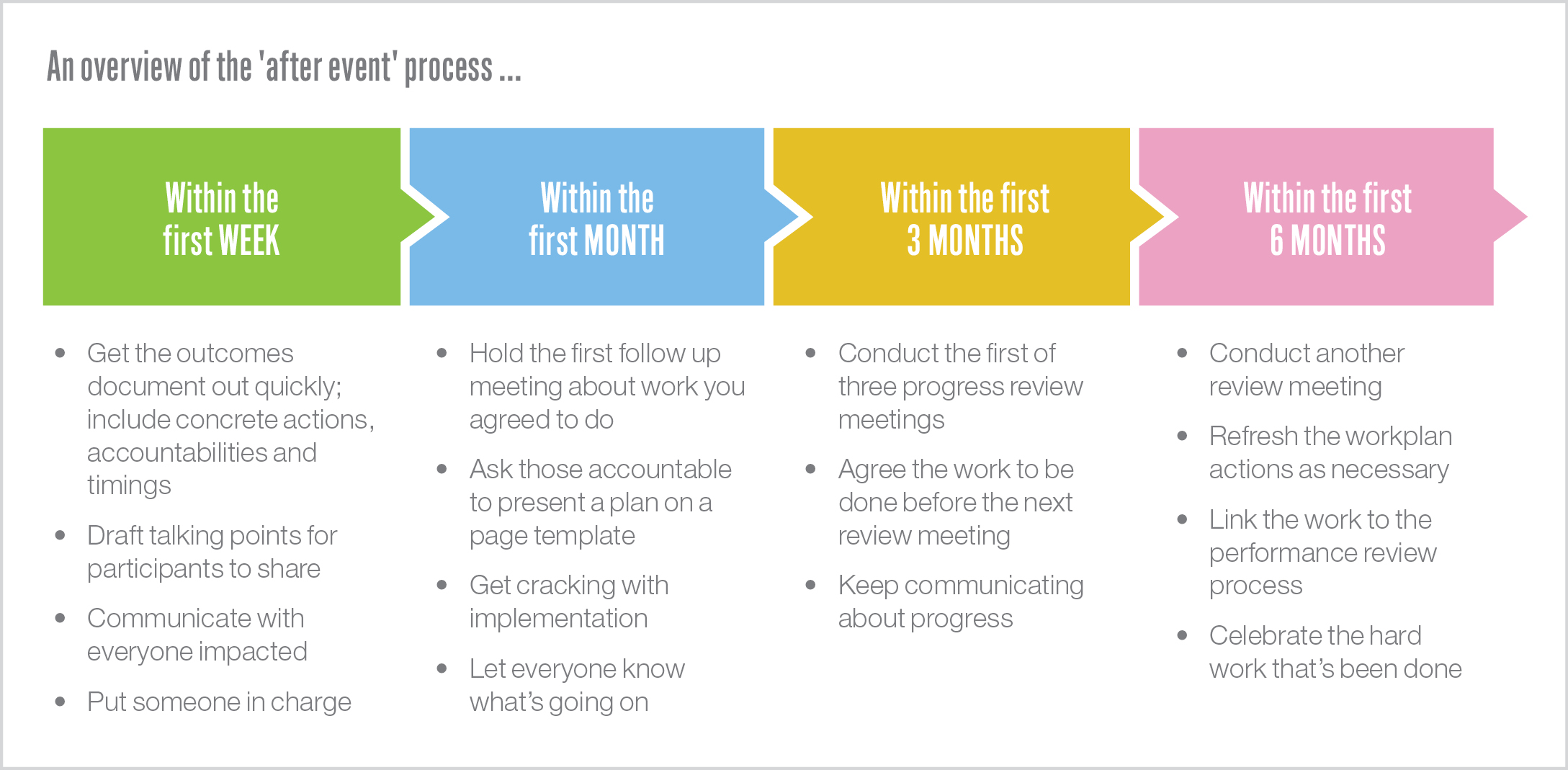After the event: How to get full value from your strategy workshop outcomes
Hard though it is, choreographing a great strategy workshop, with meaningful, compelling outcomes is only half the battle. The other half is doing something with them – committing to a series of interrelated next steps and getting them done.

Board and executive team strategy workshops are expensive, as much as $50,000 a day, if you include the value of participants’ time, consulting fees associated with expert facilitation and event management – and the travel, venue and other costs if you go offsite.
It’s perhaps not surprising then that organisations are prepared to invest this kind of money in a one or two day event. There’s a lot at stake: typical strategy workshop topics – What’s most important to us? Where will we focus our efforts? What will we fund or defund? – have far reaching implications for programs of work, with annual budgets often thousands of times the cost of the workshop.
When one of our larger listed clients takes their board and executive team offsite every year, they make major decisions about a body of work that costs about 200,000 times as much as the workshop.
While it’s not hard to justify the investment, it is important to get full value from the workshop outcomes.
Let’s say you have a very successful strategy workshop: you come to a view on what’s changing in the world and what it means for the organisation, you answer intractable strategic questions, you align on objectives and strategic priorities. Everyone is genuinely excited. What happens next? What are the steps you can take after the workshop? How can you give your team the best chance of acting on what they decided to do?

What to do within the first week of the workshop
Get the workshop outcomes document out quickly, certainly within the week and preferably much sooner. Make sure that there are concrete decisions and attendant actions coming out of the workshop, and that the corresponding ‘single point’ accountabilities and timings are unambiguous. The actions should be shared, and the senior group should, where possible, play a central role.
Draft four or five talking points for workshop participants to have on hand when their colleagues inevitably ask them, ‘How did it go? What did you do?’ It can also help to draft a workshop narrative, for workshop participants, to crystallise the outcomes.
Communicate with everyone impacted by the workshop outcomes. Depending on the size of your organisation, different communications apertures may be appropriate – an all staff town hall meeting, a departmental meeting cascade, a video, an email.
These initial communications convey the seriousness with which management is taking the workshop outcomes.
Agree what Franklyn Covey calls the ‘cadence of accountability’, the rhythm of meetings and interactions to which you will commit to keep the work you agreed to do at the workshop on track (McChesney, Covey, & Huling, 2012). Book the meetings.
Put someone in charge of the work, someone senior, with the clout, skills and ‘dog with a bone’ mindset to get it done. This person should ideally be the CEO, or a senior executive team member with the strong, visible backing of the CEO.
Within the first month
Hold the first meeting about the work you agreed to do. Ask those you charged with the ‘single point’ accountability and timings to populate, pre-circulate and present a plan on a page template for their specific work products. Provide feedback; ask them to quickly iterate the plans on a page, as necessary; and give them permission to get cracking with implementation, if they haven’t already started.
Report back to the workshop participants, and anyone else with an interest in the workshop outcomes who has been involved in a prior communications loop, about how the work is going – the good and the bad, what’s been done and what hasn’t, and what’s next.
Within the first three months
Conduct the first of three progress review meetings at three-monthly intervals. Bring together the senior group. Public accountability gets people moving. Recall what was supposed to be done. Establish what has been done. What are the results so far? What have we learnt? What do we need to change? What support can the senior group provide? What work will be done before the next review meeting? What will be the markers of success we will look at?
Keep communicating about how the work is progressing, particularly any wins. There’s a reason change management guru John Kotter (1995) suggested ‘over communicating by a factor of ten’.
Within the first six months
At the second quarterly review meeting – the six-month point – refresh the work you agreed to do at the workshop as necessary. Circumstances change. Some decisions will be wrong. Some ideas won’t work.
Celebrate the effort that’s been put in and the results so far. Make the link to the performance review process so that people’s contributions can be formally recognised.
***
Most of what we have laid out above is common sense, but it is surprisingly uncommon practice. By committing to do what we have suggested, you can give your organisation the best chance of getting the return on investment you and your colleagues deserve for the hard work you put into your strategy workshop.
References
Kotter, J.P. (1995, May-June). Leading change: Why transformation efforts fail. Harvard Business Review.
McChesney, C., Covey, S., & Huling, J. (2012). The four disciplines of execution. New York: Free Press.
Want to know more?
For more information please contact us below or call the office on 03 9428 8817.
